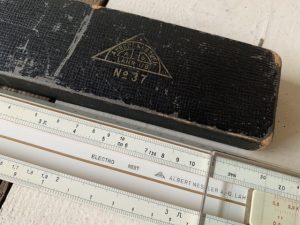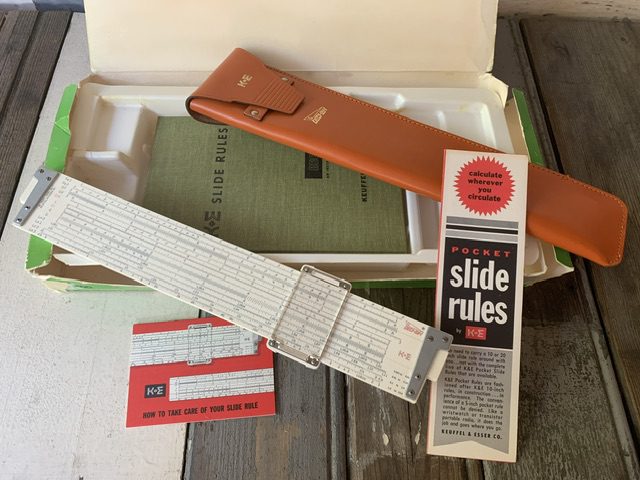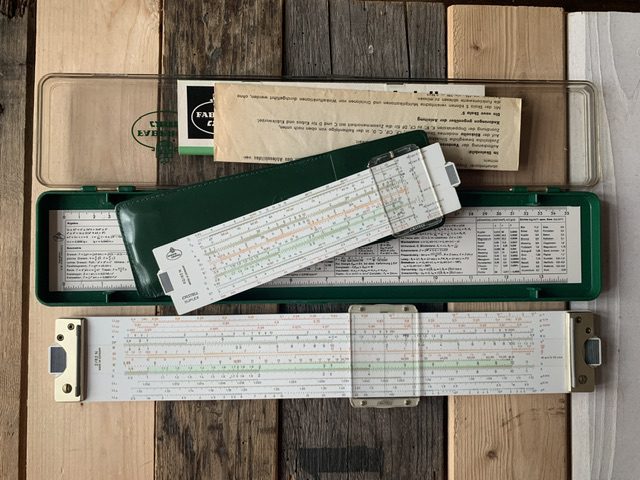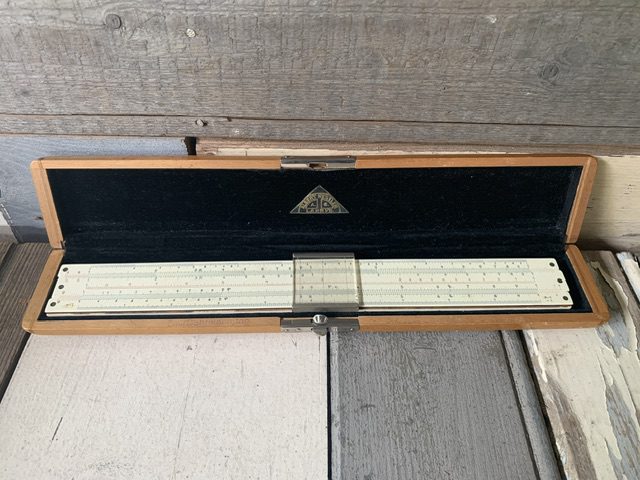World famous slide rules

How does a slide rule makes this list of world famous slide rules? Read on and find out! Most people heard about the slide rule as a predecessor to the hand held electronic calculator. But besides the standard slide rule many had to use in school there are also a few very famous ones.
The first slide rule ever made
The slide rule as we know it was invented around 1622 by William Oughtred, an Anglican minister in England, when he placed two sliding wooden logarithmic scales next to each other and thus created the first sliding rules. Unfortunately there are no pictures available of this famous slide rule. But…there is the Oughtred Society , dedicated to the preservation and history of slide rules and other calculating instruments..and thus the most complete information source on slide rules on the World Wide Web!
Slide rule from space
The Picket N600-ES 5 pocket model became famous as ‘the slide rule that went to the moon’ and was used on five Apollo missions. It served as a backup calculator. The original used by Buzz Aldrin on Apollo 11 sold for $77 675 in 2007. The one use by Neil Armstrong was donated to a museum and the Pickett N600-ES rule used by the crew of Apollo 13, in 1970 was transferred from NASA to the Smithsonian Air and Space Museum in 1984. It looks like the one below and you can find the specs here: Pickett N600-ES Log Log Speed rule sleeve 1960 USA

In the movie “Moonfall” from 2022 the character K.C. Houseman, again works a slide rule in space to save the mission.

Staying in the movies section, making slide rules famous. How about this one. Spock from Star Trek (a.k.a. Leonard Nimoy) was working a dead reckoning computer or flight computer on the TV-screen in the 1960’s.
The slide rule below was sold with many other Star Trek props in the film studies auctions. It is a Jeppesen B-1 Slide Graphic Flight Computer.
He also used a Jeppesen CSG-1 Slide Graphic Flight Computer as shown below.

The Nestler for European Scientist – the Einstein slide rule
In the first part of the 20th century some of the world famous scientists who where involved with solving earth shattering mathematic equations. I am talking about Albert Einstein the theoretical physicist and inventor, Werner Von Braun, the rocket scientist for NASA and Sergei P. Korolev the chief designer 0f Soviet spacecraft.
It is known that Von Braun and Einstein (being from Germany) were fond of using their German Albert Nestler slide rules. Especially the standard Rietz model 23R as depicted above and below. It is the early model with screws in the ends from their era.
From the personal possessions of Von Braun and Korolev their slide rules, model Nestler 37 made it into the Smithsonian Air and Space Museum! Shown below.



The Nestler 37 was a specialist model called the “Electro” with scales for Electrical Constants.
The last the best – the most powerful slide rules
The Deci-lon series from Keuffel and Esser is a model with 26 scales, 13 on the front and 13 on the back. It is the most elaborate one they produced in the late 1960’s and early 1970’s.
 It was available as a full size version named the Deci-lon 10 (10 inch scales). The pocket version is named the Decilon 5 which was half the size. Both made of shatterproof synthetic material with plastic cursor and metal reinforcements on the ends. The earlier versions also had nice red / black grips on the end of the slider (until there were production problems and these were omitted).
It was available as a full size version named the Deci-lon 10 (10 inch scales). The pocket version is named the Decilon 5 which was half the size. Both made of shatterproof synthetic material with plastic cursor and metal reinforcements on the ends. The earlier versions also had nice red / black grips on the end of the slider (until there were production problems and these were omitted). 
The model Duplex and the Novo Duplex are amongst the last rules produced by Faber Castell. These are at the very top of the slide rule development by this German manufacturer. The model Novo Duplex has the large total of 30 scales, 15 on the front and 15 more scales on the back. It also came in a pocket version, with number 62/83N (shown below), the full size had the number 2/83N.

And from the same period is the model Duplex with 24 scales (of which several different ones compared to the Novo Duplex) and a different color scheme as well. Also take a good look at the multiple hairline cursor and the beautiful metal reformed ends.

The standard sized model is the number 2/82N, the pocket size is the 62/82N, shown together below. The pocket versions also have the black grip at the end of the slider but not the metal reinforcements.

A reader made a great suggesting by asking me to add the “Pickett N3 and Pickett N4 to the list of great rules. Me myself not being entirely educated on the USA-made slide rules I gladly follow this suggestion. And let mr. Hutchins himself explain why this rule should be ont the world famous slide rule list at his own website. Shown below the N3-ES pocket slide rule.

And for good measure below the N4-T pocket version in traditional white.

This rounds up the list of world famous slide rules. Slide rules that are recognized by every collector and would make an interesting collection on their own…so all together now (minus the 2 above):










